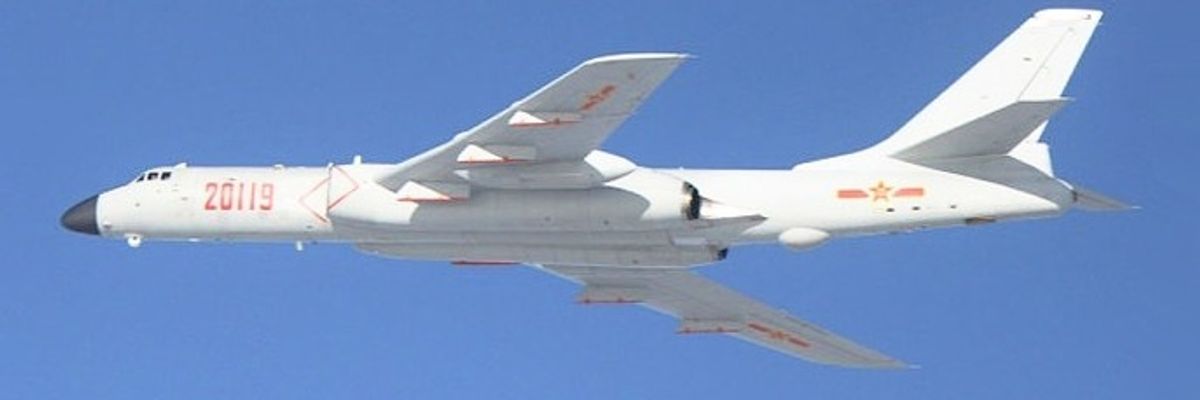Dozens of Chinese military flights through parts of Taiwan’s Air Defense Identification Zone (ADIZ) over the past month have caused an unwarranted panic that hawks in the U.S. have stoked and exploited for their own purposes.
Media hysteria and misinformation about these events have served to ratchet up tensions unnecessarily and to create an impression with the public that China is behaving far more aggressively than it is. The eagerness with which some national security analysts and reporters have mischaracterized what these flights represent has been alarming, because it shows how quickly any Chinese actions can be used to create a crisis atmosphere when there is no reason for it.
As U.S.-Chinese tensions increase due to mutual suspicion and distrust, these false alarms will likely become more frequent and potentially much more dangerous. If the United States is to keep these tensions from spiraling out of control, it should not take any provocative actions that could trigger a real crisis.
Contrary to many sensationalist reports and social media posts, Chinese forces have not violated Taiwanese airspace, nor have they flown “over” Taiwan. In fact, these Chinese flights have mostly taken place in one corner in the southwest of Taiwan’s ADIZ hundreds of miles from the island, and they have all been operating in international airspace. Whether through sloppiness or a desire for clicks, media outlets and analysts that should know better have effectively misled their audiences into thinking that China has been routinely committing acts of aggression against Taiwan when it has not done that. Kevin Baron, the executive editor of Defense One magazine, claimed that the flights had gone “over” Taiwan, compared the flights to Russian military intervention in Ukraine, and then suggested that the Chinese government was “testing” the United States and preparing to do something similar here.
An ADIZ is defined as an area well beyond a country’s airspace, and that airspace extends only 12 miles out from the coasts. Several countries, including the United States and China. have established ADIZs to provide them with advance warning of approaching aircraft, and other governments send their own planes into these zones without notifying the other side on a semi-regular basis. The U.S. has repeatedly sent bombers through the ADIZ that China established over the East China Sea in 2013, and Russia sometimes sends its planes into the American ADIZ around Alaska. Part of Taiwan’s ADIZ even overlaps with a portion of the Chinese mainland itself. As Michael Swaine observed earlier this week, the unprecedented number of flights is genuine cause for concern, but it is not cause for the alarmist reaction that we have seen.
So why is China sending so many planes through part of Taiwan’s ADIZ? As Bonnie Glaser told The Guardian this week, “The Chinese are using these flights increasingly for training purposes and this is actually the end of the typical annual training cycle. The other purposes they serve is to signal to the United States and Taiwan not to cross Chinese red lines. And to stress Taiwan’s air force, to force them to scramble, to stress the aircraft, the pilots, force them to do more maintenance and test the responses of Taiwan’s air defence system.”
These flights are annoying, and they do place some strain on Taiwan’s air force, but we should not exaggerate the danger they pose to the island. The worst thing that Washington could do is to overreact and take its own provocative actions in response.
Threat inflation is a given in U.S. foreign policy debates, but it has been remarkable to see once again how easily media coverage can turn into full-blown fearmongering at the drop of a hat. Much of the coverage of this story in the last week has been very poor and inflammatory, and in some cases the commentary has been completely inappropriate. It is disturbing to think how a real crisis in the Taiwan Strait would be covered. It is worth asking whether our media outlets are even capable of responsibly reporting on such an important issue.
The Biden administration accurately criticized the flights for being provocative, but it has not blown them out of proportion. President Biden said earlier this week that he had spoken with Xi Jinping, and he stated that both had agreed to abide by what the president vaguely referred to as “the Taiwan agreement.” However, this affirmation of the status quo may no longer be enough to calm things down.
As Swaine noted: “Formulaic repetition by Washington of its continued adherence to the One China policy, and Beijing’s continued verbal support for a peaceful solution to the problem will not put a halt to this dangerous dynamic either.” The constant agitation in Washington for a more aggressively anti-Chinese posture in the region undermines Biden’s affirmations of the status quo. Recent arguments for giving Taiwan an explicit security guarantee have only contributed to the problem further.
Nothing could turn an imaginary crisis into a real one faster than an explicit U.S. pledge to defend Taiwan. Not only would this be an abrupt break with the status quo that has kept the peace for four decades, but a policy of “strategic clarity” would represent a direct challenge to China over a matter of vital importance that the Chinese government could not ignore. An American pledge to defend Taiwan would likely be tested early on, and it is doubtful that anyone in our government has fully thought through the implications of what such a commitment would require. The public is wholly unprepared for what a conflict over Taiwan would involve and what it might end up costing the United States.
Decades of waging war against much weaker states and terrorist groups have helped Americans forget how dangerous it is to court unnecessary conflict. As Daniel Davis recently pointed out, “the very best outcome we can hope for is a U.S. military that is left severely damaged, thousands of service members killed and wounded, and a massive security and financial burden of defending Taiwan indefinitely,” and that best-case scenario is not the most likely outcome. An explicit security guarantee to Taiwan would put the U.S. on a path for war with China sooner or later, and there is a good chance that this is a war that we would lose.
The United States can and should continue assisting Taiwan to prepare its own defense to discourage China from ever making an attempt to seize the island by force, but it should not make an explicit guarantee to go to war on Taiwan’s behalf. Making such a guarantee is more likely to trigger a crisis and a war than it is to prevent one. The best thing to be done under the circumstances is to seek to reduce tensions with China and to back away from the militarized rivalry with them that our government has been pursuing. Unfortunately, the irresponsible hawkish fearmongering over this week’s events threatens to move the U.S. in the opposite direction.
















